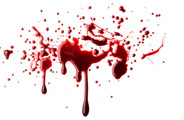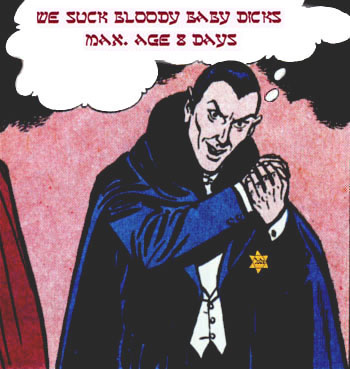Excerpt from A. Toaff, Pasque di sangue, Bologna, Il Mulino, 2008, pp. 363-398
Afterword
Trials and Historical Methodology.
In defence of "Pasque di Sangue"
Introductory remarks:
"Pasque di Sangue" was not written to prove the reality of Jewish ritual murder. It was written to study, in an objective way, the Jewish obsession with blood, both animal and human, during the Middle Ages -- an obsession which continues unabated to this day. In this sense, Toaff never "recanted" one single iota.
Yet the claim that "Jews are disgusted by the ingestion of blood" is now, and always has been, their first line of defence against all charges of ritual murder.
---

[Beginning of excerpt:]
…I concluded that there were indeed grounds to suppose that the magical, symbolic use of blood, dried and reduced to powder,
Page 365]
had become, over time -- despite rabbinical opposition -- an integral part of particular rites and liturgies relating to the Jewish Passover.… these consecrated anathemata acquired additional, terrible, magic power when a few grains of powdered Christian blood were symbolically dissolved in wine, transforming it into the blood of Edom – Christianity, the uncompromising persecutor – against whom these curses were directed… the magical, therapeutic, alchemical use of blood, warding off evil and bringing good fortune, was used in support of this deadly blood calumny…
[Page 381]
…In the heart of the Christian and Jewish West, the Jews, with slight hesitation, ingested animal and human blood, cooked, dried and reduced to powder, attributing to it extraordinary magical, exorcistic and therapeutic powers. That which appears repellent to us today, possessed, at the time, an irresistible fascination and power of seduction. Thus, recourse to oils and balms extracted from fetid mummies; medications based on powders prepared from the craniums of hanged men; unguents and pomades of human fat, encountered, in practice,
Page 382]
no obstacles impeding their use, among either Christians or Jews…
The handbooks of segullot, secret remedies and medications drawn up and disseminated by experts in the Caballah, as practiced by Ashkenazi Judaism in the Middle Ages and the early modern era, contain a vast range of recipes based on blood, used as a haemostatic and in oral transfusions, the magical and therapeutic efficacy of which was taken for granted. The lists of the “secrets” of Elia Loans, the Baal Shem of Worms, of Shabbatai Lipschütz, Sacharja Plongiany Simoner and many others -- more or less well known -- Ashkenazi specialists in spagyrics [herbal medicines using alchemical procedures], prescribe dried, young human blood as a coagulant powder believed to possess extraordinary virtues in healing the circumcision wound. The blood of the ibex was prescribed to cure epilepsy. Another cure for epilepsy was the menstrual blood of a virgin, dried and dissolved in wine; that of rabbits was used to facilitate pregnancy, while young menstrual blood was prescribed to mitigate excessive menstrual flow (36).
---
36). As correctly observed by David Abulafia and Gadi Luzzato Voghera, one cannot exclude the possibility that miraculous unguents and syrups with portentous therapeutic and magical effects, with esoteric and fantastic names (Dragon’s Blood, Tiger’s Balm), were sometimes mere catchwords for purposes of effect, mere evil-smelling homemade counterfeits.
---
Love potions were prepared with human blood, extracted from the sufferer’s little finger, dissolved in wine and administered to a beloved person resistant to courting.
… the same unchanged recipes are reproduced over and over again for centuries. We have obvious proof of this in the utilisation of young blood in powdered form (even, and particularly, of Jewish and not Christian children) as a marvellous haemostatic for the circumcision wound, recommended in the segullot handbooks of the Baal Shem of Worms (of Lipschütz and Simoner, apparently already adopted and widespread in the 15th century Ashkenazi communities of
Page 383]
both Germany and Italy, as reported, among other things, by the accused at Trent, in testimony which must be considered quite credible. We should not therefore be astonished if a large proportion of these ancient recipes (rarely, those contemplating the use of blood) are still republished in Israel today, intended for a well-defined, but in no way restricted, clientele. Among this segment of the population (often the more Orthodox, but not always), of not inconsiderable importance and numbers, long-established superstitious customs and a faithful adherence to the empirical remedies of the practical Caballah continue to possess very considerable importance. As for the ritual responsals, their authors, among them Jacob Reischer of Prague (1670-1734), in permitting the use of blood taken orally (in this case, animal blood) for therapeutic purposes, but not in the case of serious illnesses, make reference to the custom, in force from time immemorial in the German-speaking territories, so much so as to permit the rabbis to declare the custom, flatly, minhagh Israel, that is, a “Jewish custom consolidated over time”, capable of possessing validity even in contradiction to the standards of the Torah (37).
---
37). I believe I answered this point in relation to Ruggero Taradel’s objections (L’Accusa di sangue tra storia e leggenda, in “Morashah”, 15 February 2007), a scholar whom I respect but whose works relate to the period subsequent to that with which I concerned myself in the book.
---
As I said, the rabbis found themselves, often obtorto collo [against their will] and a posteriori, constrained to accept a reality which conflicted with the norm. They knew they were powerless to modify a deeply-rooted custom, and therefore opted for the only alternative remaining available to them: that of limiting the consequences of an obvious violation of the dictates of the Torah. To accomplish this, they decided to permit the consumption of blood, in minimum quantities, only when dried and deprived of any alimentary connotation (“when it has been rendered dry to such a point as to be transformed into a piece of wood, all humidity having been eliminated”) (38).
---
38). On the dispensation for the consumption of “cooked blood”, the structure of which has been radically modified, in addition to the sources already cited by myself in Pasque di sangue, see Y. Engel, Commentary on Talmud, Menachot, 21a; I, Meir, Responsa, Yoreh De’ah, paragraph 11, Tel Aviv, 1961, pp. 27-32. I wish to think rabbi Menachem Sreter of Jerusalem for kindly indicating the texts in question to me (written communication of 7 April 2007).
---
The merchants of Jewish blood, who, together with their Christian colleagues, travelled the roads of Europe with their waxed bags, presented their clients with rabbinical certificate of suitability (kasherut), guaranteeing a completely dessicated product without alimentary significance. This powdered blood could, therefore, be used during the year for whatever curative or magical purposes were thought fit, without fear of violating any rabbinical interdiction. In the case of unguents and syrups prepared from the bodies of mummies, the rabbis obviously permitted their use if the raw material was extracted from the cadavers of gentiles and not Jews (39).
---
39). Cfr. Sperber, Minhaghe’ Israel, p. 61.
---
In this sense, they were not too far away from Israel da Brandenburg in his deposition before the Trent judges, when he stated
Page 384]
that the consumption of blood was permitted only when it involved the blood of non-Jews (40).
---
40). Cfr. supra, p. 105 [104].
---
...Apart from the fact that, as I have noted in detail in my study, the compendiums of empirical remedies and segullot of the Ashkenazi milieu contain numerous recipes based on young and menstrual blood, to be administered dried, in wine, the thing that leaves me all the more perplexed – and more than just a little – is the utter naiveté of my critics when it comes to texts of Jewish ritualistic law. In fact, the prohibition against the consumption of animal blood is considerably more serious than that against the consumption of human blood. In the Torah (Lev. 7:26), it is written: “Moreover ye shall eat no manner of blood, whether it be of fowl or of beast, in any of your dwellings”. On this basis, the ritualists deduced that, while the prohibition against animal blood was to be considered a “negative precept” (lo ta’aseh), prescribed directly by the Torah, while the prohibition relating to human blood was said to fall into the category of “affirmative precepts” (‘aseh), which are less serious, since they are merely established by rabbis. This was the opinion of Maimonides. For his part, the famous French exegetist Rashi (R. Shelomoh Izchaki), who lived at Troyes in the 11th century, explained, the sole reason for the prohibition against the consumption of human blood lay in the fact that it might be confused with animal blood, which is prohibited by the Torah. Rashi’s followers, the French-German Tossifists, went so far as to permit the consumption of human blood, as long as it was obvious, and certain, that it was not animal blood (41).
---
41). R. S. Izchaki (Rashì) commentary on the Talmud, Ketubot, paragraph 1; Tossafot on Talmud, Keritot 21b.
---
Lazzaro da Serravalle’s confession at the Trent Trial, according to whom the Biblical prohibition concerned only animal blood (quod lex Dei [...] loquitur de sanguine bestiarum) (42) is therefore fully in accordance with these premises.
---
42). Cfr. supra, p. 107 [104].
---
In an essay soon to be published in this regard, the author, the rabbi Elkana Hildesheimer, based on this and other data extracted from the rabbinical texts, concludes that:
Page 385]
“The Ashkenazi Jews, like the others, have eaten foods not permitted by the rite, sometimes asking and obtaining a problematical rabbinical dispensation. This is also true in the case of blood, where the prohibition against the consumption of human blood was generally handled with a certain carelessness -- certainly greater than that relating to the blood of beasts or birds. The consumption of human blood was not only less repellent than it may appear to us today, but in not infrequent cases the rabbis found themselves compelled to permit its use (43).”
---
43). Cfr. E. Hildesheimer, Consumo di cibi proibiti, senza che sussista pericolo di vita, Ramat Gan, 2006. The essay was written in the context of a Graduate Seminary on the topic of ritual murders, held at the Department of Jewish History of the University Bar Ilan.
---
Page 386]
…In the moment of reciting the curses, for the head of the family responsible for the rite, shaking a few grains of powdered Christian blood into the wine (the same dried and powdered Christian blood which, during the year, had been used to provide for a thousand other needs, whether therapeutic or intended to bring good luck), the blood was thought to possess the power of symbolically transforming the contents of the chalice into the blood of Edom. This gesture is said to have provided additional potency potency to the curses, conferring upon them wondrous efficacy, and reinvigorated the terrible curses which, as Yuval has written, "constituted per se a destructive magic born from a violent and aggressive Messianism" (46).
---
46). Cfr. Yuval, “Two Nations in Your Womb”, p. 145.
---
For full text, click here

we suck bloody baby dicks maximum age 8 days
...but Jewish ritual murder is absurd
because Jews are disgusted by the ingestion of blood!
To return to general discussion of Toaff's newly invented fairy tale of the "voluntary donors", click here
To return to complete text from which this is an excerpt, click here
To return to excerpts from "Jewish Monsters", click here
---
See also:
Comparison between the original and revised editions of BLOOD PASSOVER [Pasque di Sangue], click here
For a short summary of deletions and interpolations, click here
For added chapter of no interest to anyone, click here
For Ariel Toaff's Apologia pro Vita Sua, click here
For quotes from Ronnie Po-chia Hsia, click here

